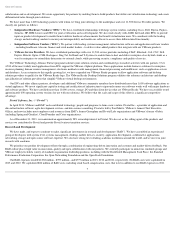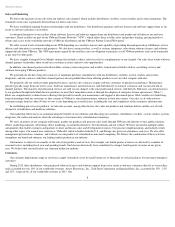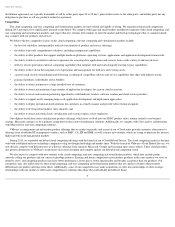VMware 2013 Annual Report Download - page 19
Download and view the complete annual report
Please find page 19 of the 2013 VMware annual report below. You can navigate through the pages in the report by either clicking on the pages listed below, or by using the keyword search tool below to find specific information within the annual report.
Table of Contents
The failure by customers to renew large license agreement transactions on a satisfactory basis could materially adversely affect our business, financial
condition, operating results and cash flow.
Our core customers are large enterprises with multi-year enterprise license agreements each of which involves substantial aggregate fee amounts. The
failure to renew those transactions in the future, or to replace those enterprise license agreements with new transactions of similar scope, on terms that are
commercially attractive to us could materially adversely affect our business, financial condition, operating results and cash flow.
Our current research and development efforts may not produce significant revenues for several years, if at all.
Developing our products and services is expensive. Our investment in research and development may not result in marketable products or services or
may result in products and services that take longer to generate revenues, or may generate less revenues, than we anticipate. Our research and development
expenses were over 21% of our total revenues in 2013 and 2012. Our future plans include significant investments in software research and development and
related product opportunities. We believe that we must continue to dedicate a significant amount of resources to our research and development efforts to
maintain our competitive position. However, we may not receive significant revenues from these investments for several years, if at all.
Our products and services are sold using ELAs and through our transactional business, and this strategy may not drive long-term sales and revenue
growth.
We sell our products and services through two primary means, which we refer to as our ELA and our non-ELA, or transactional, sales.
ELAs are comprehensive long-term license agreements that provide for multi-year maintenance and support and constitute an increasing percentage of
total overall sales. Currently, one-quarter to one-third of our overall sales are comprised of ELAs.
17
• changes in customers’
budgets for information technology purchases and in the timing of their purchasing decisions;
• the timing of recognizing revenues in any given quarter, which, as a result of software revenue recognition policies, can be affected by a number of
factors, including product announcements, beta programs and product promotions that can cause revenue recognition of certain orders to be deferred
until future products to which customers are entitled become available;
•
the sale of our products and services in the time frames we anticipate, including the number and size of orders in each quarter;
• our ability to develop, introduce and ship in a timely manner new products and services and enhancements that meet customer demand, certification
requirements and technical requirements;
•
the introduction of new pricing and packaging models for our product offerings;
•
the timing of the announcement or release of upgrades or new products and services by us or by our competitors;
• our ability to maintain scalable internal systems for reporting, order processing, license fulfillment, product delivery, purchasing, billing and general
accounting, among other functions;
•
our ability to control costs, including our operating expenses;
•
changes to our effective tax rate;
•
the increasing scale of our business and its effect on our ability to maintain historical rates of growth;
•
our ability to attract and retain highly skilled employees, particularly those with relevant experience in software development and sales;
•
our ability to conform to emerging industry standards and to technological developments by our competitors and customers;
•
renewal rates and the amounts of the renewals for ELAs as original ELA terms expire;
• the timing and amount of software development costs that may be capitalized beginning when technological feasibility has been established and
ending when the product is available for general release;
• unplanned events that could affect market perception of the quality or cost-
effectiveness of our products and solutions; and
•
the recoverability of benefits from goodwill and acquired intangible assets, and the potential impairment of these assets.
























